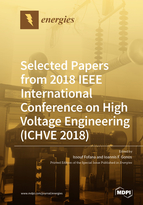Selected Papers from 2018 IEEE International Conference on High Voltage Engineering (ICHVE 2018)
A special issue of Energies (ISSN 1996-1073).
Deadline for manuscript submissions: closed (30 June 2019) | Viewed by 54972
Special Issue Editors
Interests: dielectrics and electrical insulating materials; insulating fluids; diagnostic and monitoring; atmospheric icing of power network equipment; electric discharge and lightning-related phenomena; HV testing techniques and computer modeling
Special Issues, Collections and Topics in MDPI journals
Interests: substations; instrumentation and measurement; electrostatic discharge/lightning; power systems protection
Special Issues, Collections and Topics in MDPI journals
Special Issue Information
Dear Colleagues,
The 2018 IEEE International Conference on High Voltage Engineering (ICHVE 2018) will be held on 10–13 September 2018 in Athens, Greece, and is organized by the National Technical University of Athens, Greece, and is endorsed by the IEEE Dielectrics and Electrical Insulation Society. This conference has attracted a great deal of attention from international researchers in the field of high voltage engineering. This conference can, not only provide an excellent platform to share knowledge and experiences on high voltage engineering, but also will provide the opportunity to present the latest achievements in power engineering, including topics of ultra-high voltage, smart grid, new insulation materials, and their dielectric properties. For more information about ICHVE 2018 please use the following link: http://ichve2018.ece.ntua.gr/
Prof. Dr. Issouf Fofana
Prof. Dr. Ioannis F. Gonos
Guest Editors
Manuscript Submission Information
Manuscripts should be submitted online at www.mdpi.com by registering and logging in to this website. Once you are registered, click here to go to the submission form. Manuscripts can be submitted until the deadline. All submissions that pass pre-check are peer-reviewed. Accepted papers will be published continuously in the journal (as soon as accepted) and will be listed together on the special issue website. Research articles, review articles as well as short communications are invited. For planned papers, a title and short abstract (about 100 words) can be sent to the Editorial Office for announcement on this website.
Submitted manuscripts should not have been published previously, nor be under consideration for publication elsewhere (except conference proceedings papers). All manuscripts are thoroughly refereed through a single-blind peer-review process. A guide for authors and other relevant information for submission of manuscripts is available on the Instructions for Authors page. Energies is an international peer-reviewed open access semimonthly journal published by MDPI.
Please visit the Instructions for Authors page before submitting a manuscript. The Article Processing Charge (APC) for publication in this open access journal is 2600 CHF (Swiss Francs). Submitted papers should be well formatted and use good English. Authors may use MDPI's English editing service prior to publication or during author revisions.
Keywords
- electromagnetic fields
- transients and EMC
- grounding systems
- monitoring and diagnostics
- power and industrial applications
- high voltage insulation systems
- high voltage testing and measurement
- aging, space charge, and maintenance
Related Special Issues
- Selected Papers from 2016 IEEE International Conference on High Voltage Engineering (ICHVE 2016) in Energies (23 articles)
- Selected Papers from the 2022 IEEE International Conference on High Voltage Engineering (ICHVE 2022) in Energies
- Selected Papers from 2020 IEEE International Conference on High Voltage Engineering (ICHVE 2020) in Energies (17 articles)







